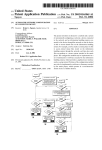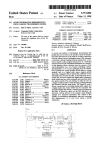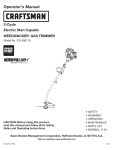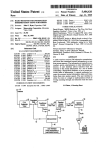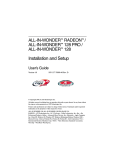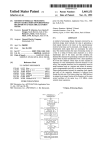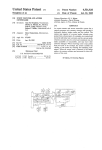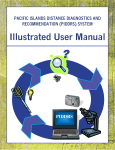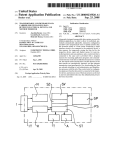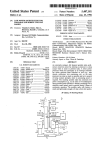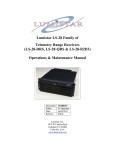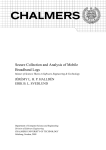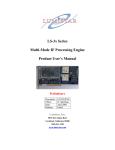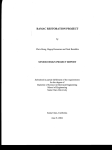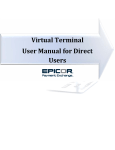Download 1101i 51115111111111 111111111 11
Transcript
||||||||||||||||||||||||||| [1101i51115111111111 111111111 11 United States Patent [191 [11] Patent Number: [45] Date of Patent: Ryan [54] METHOD AND SYSTEM FOR AUDIO INFORMATION DISSEMINATION USING VARIOUS MODES OF TRANSMISSION _ _ 5,524,051 Jun. 4, 1996 0552051 7/1993 European Pat. Off. ....... .. H04M 3/50 2651352 WO8704309 3/1991 7/1987 France .................. .. GOSG 1/096 WIPO ............................ .. H04B 7/00 Primary Examiner~Bernarr E. Gregory [75] Inventor: John 0. Ryan, Cupertrno, Calif. Attorney, Agent, or Firm_Gerow D_ Brill [73] Assignee: Command Audio Corporation, [57] Sunnyvale’ cahf' ABSTRACT A system and method of information dissemination that permits the user to listen to the speci?c content of informa— tion when and where he or she wants to. Aradio or television [21] APP1- NO-I 223,641 [22] F?ed' [51] [52] Int. Cl.6 ............................... .. H04L 9/00; H04B 1/06 US. Cl. ................................. .. 380/9; 380/49; 380/50; picture area television transmission a television separate audio program transmission or a dedicated radio channel and [58] 455/45; 331/34 Field of Search ............................ .. 455/1511, 151.2, stores the transmitted information in a memory. A user interface allows selection from the memory of the stored 45/1514, 1861; 381/29’ 30’ 34, 59’ 110; 348/473; 379/38; 380/4’ 9, 19’ 20’ 497 50 information via a set of menus controlling a hierarchical database, so as to access particular items of the information. Typically the system includes RAM and/or a magnetic storage medium such as a digital audio tape, a magneto optical mini-disk, a magnetic disk or optical disk, su?icient - , receiver system receives information from an FM subcarrier, Apr' 6’ 1994 [56] a television vertical blanking interval transmission, an active References Cited U-S' PATENT DOCUMENTS 4,266,243 4,393,277 4,473,324 to store information for several hours of audio output. A 5/1981 Shutterly ............. .; .................. .. 380/19 7/1933 Besen et a1 _____ " 379/33 9/1984 Claytor ..... __ _ 340/325” 4,682,368 7/1987 Takahashi .. 4,788,543 11/ 1938 Rubin ------- -5,042,070 8/1991 Lmna et al5,210,611 deconnPression device accepts the accessed Compressed digital audio information items and transforms them into audible speech signals. The user interface is either a voice 455/381 - 340/825-44 ----- -- 381/59 control or a single or multi-position switch allowing scan ning through and selection from the menu items. The system is also capable of transmitting alphanumeric data and con 5/1993 YCC et a1. .............................. .. 348/473 verting this alphanumeric data to an audible fonn using a FOREIGN PATENT DOCUMENTS 0128093 12/1984 voice Synthesizer European Pat. Off. ....... .. H04N 7/08 47 Claims, 4 Drawing Sheets Antenna 10 , ...................... i l l 5 : l l ............................................................................................. -_ 12 r) 1e Encrypted Data , Tuner / 28 26 F) / F) Conditional Access Control Comm] i : : i i : i f] i : i N i \l/ +1353 2%? [J : p Voice 5 . a0 D/A Plain Data 1 i: f‘) Memory Circuitry 14 39 43 Synthesizer r”) 20 45 I\/ User Interface (Voice recognition or N40 pushbutton control) 34 I E Audio 47 N42 ‘i Swnch N lE Microcontroller 18 46 i - AMP 5 36 as l: 5 5 5 : US. Patent Jun. 4, 1996 Sheet 1 of 4 5,524,051 m mm \|\m5w:momtmzE n__>_< n " n22 m m NF 3 om mm \ mR285 v2-8Eo6mm<5Eow;mEo <E “uw?bocm 21 z mcwpx \ howm2m?5CE6Hm:Ea0 A2‘m6:5\38.65 m m m: 5 mm n_.@N\k \K \|\ 9“ rmwwmmm6~_wm£c>w #1.._n_O.=\_C~OQO mcozsnwm. W 32m@5625032 \k?n58 m #2 0F.59“. 5,524,051 1 2 METHOD AND SYSTEM FOR AUDIO INFORMATION DISSEMINATION USING VARIOUS MODES OF TRANSMISSION ing with the regular television picture. The decoded data can include text and sound. An additional channel of communication for data or audio transmission is the Separate Audio Program channel avail able in television broadcasting. All of these systems have the disadvantage that the CROSS REFERENCE TO RELATED APPLICATION This invention is related to a copending commonly owned listener or user of the data is restricted to a speci?c place or time to access the information. The portable radio, be it hand application Ser. No. 08/181394, ?led Jan. 12, 1994 entitled held or in an automobile, also limits the user to accessing A METHOD AND SYSTEM FOR INFORMATION DIS SEMINATION USING VARIOUS MODES OF TRANS MISSION by John 0. Ryan which is a Continuation-in~Part only the information that is presently being transmitted. SUMMARY of application Ser. No. 08/031,763, ?led Mar. 15, 1993 entitled RADIO RECEIVER FOR INFORMATION DIS The present system and method permits the user to listen SEMINATION USING SUBCARRIER BY John 0. Ryan, 15 to a speci?c news or information item when and where he or now US. Pat. No. 4,706,620. she wants to. The present invention is directed to a method and system for information dissemination using various modes of transmission and that satis?es the individual needs BACKGROUND 1. Field of Invention 20 This invention relates to a radio or television broadcasting system for transmission of audio and text information and of such a user. The invention includes a system for receiving information via a tuner that extracts digitized alphanumeric data and/or compressed audio data from the Vertical Blank ing Interval of a television station’s video signal, the active television picture area using the WavePhore system, the more specially to transmitting digitized audio data and text Separate Audio Program (SAP) signal from a television ' data. 25 station’s audio signal, or a system for receiving the digitized 2. Description of the Prior Art alphanumeric data or compressed audio information via Numerous systems transmit information on FM radio radio sidebands (subcarriers) which include an FM subcar subcarriers. See for instance, US. Pat. No. 5,152,011 issued rier of an FM broadcast signal. In addition, a suitable to Schwob, Sep. 29, 1992. Also known is a single sideband communication system with FM data capability for trans mission of analog voice signals. See US Pat. No. 4,852,086 issued to EastmoLd et al., Jul. 20, 1989. 30 data which is then stored as a database in a memory. A user Also known is FM radio sideband broadcasting to spe interface (for instance either a simple manual switch or voice activated control) driving a hierarchy of menus allows the user to access the information by indicating his selec tions from the menus. The system then extracts the infor cially adapted computers for transmission for instance of news and ?nancial information. Commercially available products available from Mainstream, Telemet, and DeskTop Data broadcast data over FM radio sidebands for receipt by mation from the database. A speech producing device including a decompression system and a digital to analog converter (D/A) or other speech producing device converts personal computers equipped with special FM radio receiv ers and software. Typically information is transmitted in digital form, received, and stored in the computer memory the extracted data to an audio signal for provision to the user via a loud speaker or earphones. This system may be stand alone or be a part of an existing for access by the computer user using menu driven software, The data is displayed on the computer screen in conven tional alphanumeric form. One product in this category is News Edge, a news service available from DeskTop Data, Inc. of Waltham, Mass. which delivers a number of news and ?nancial information services to a user via FM radio side dedicated transmission facility may be provided. Condi tional access circuitry in the receiver decrypts the previously encrypted digitized alphanumeric data or compressed audio radio receiver, sharing components of the radio receiver. 45 One embodiment of the user interface is a four way switch (the positions corresponding for instance to the cursor control keys on a computer) for selection from and scanning through menus listing various categories of information. Typically the system includes either volatile or non-volatile band. Software provided with the product scans incoming information and when the incoming information meets parameters set by the user, the information is saved to disk and/or displayed on the computer screen. These systems have the disadvantage of requiring a personal computer as a platform, and providing information RAM (random access memory) or a non-volatile storage medium such as a digital audio tape, a magneto-optical mini-disk, a magnetic disk or optical disk, su?icient to store information e.g. for a few hours of audio. The information only on a computer screen. The usual computer skills are is for example news, sports, weather, cultural information, needed in order to operate such systems, which tend to be 55 advertisements, commercial listings or music. The informa quite expensive. tion is transmitted in encrypted digital form using data compression techniques. The use of encryption techniques Data can also be transmitted in the Vertical Blanking Interval of a television transmission. The Federal Commu nications Commission has set aside several lines of the Vertical Blanking Interval for point to multipoint data trans controls access to the information data base as a whole or to 60 mission which may be sold to interested users. particular FM radio station subcarrier, TV station vertical In addition to using the Vertical Blanking Interval, data can be transmitted via a television channel using 384 Kpbs transmission system during the active video portion of the television channel using a system available from Wave Phore, Inc. This system piggybacks digital data within the active area of an existing broadcast signal, without interfer selected parts that the user has contracted for. Another feature is a channel skipping tuner for ?nding the 65 blanking interval, active TV picture area channel or TV station SAP charmel on which the service is provided. The speech producing device may be under either automatic or user control to produce diiferent speeds of the audio output. This control of the speed of the audio may change the pitch or change the spacing between words. Also, the user has the 5,524,051 3 4 opportunity to preselect database items, thereby to construct circuitry 39, connected to the output of memory 28 by line . 43 to provide the decompressed data to the digital to analog ' a personal pro?le so as to extract particular information without having to scan through all the menus. converter 30 for conversion of the digitized data to analog audio signals. The conditional access circuitry 16 and microcontroller 20 are furtherdescribed below. The decrypted compressed BRIEF DESCRIPTION OF THE DRAWING These and other features and other aspects of the present invention will become better understood with reference to data output of the memory 28 is accessed under control of microcontroller (microprocessor) 20 via control signals at ‘ line 22b, to determine which particular items of data stored ‘ the following description, appended claims and accompa nying drawings where: 10 accordance with the present invention; Some of the data that a user uses in such a system may be in alphanumeric form that can be easily transmitted in that form and converted to audio at the receiver via speech synthesis. Such data is transmitted in alphanumeric form for bandwidth, speed and memory conservation considerations. In order to accommodate the dual transmission of alphanu meric data as well as audio data, switch 46 controlled by FIG. 2 shows a block diagram of a transmission system in accordance with the present invention; FIG. 3 shows a block diagram of an alternative embodi ment of the apparatus of FIG. 1; and FIG. 4 shows a block diagram of a second alternative embodiment of the apparatus of FIG. 1. microcontroller 20 on line 47 determines whether the cur 20 DETAILED DESCRIPTION FIG. 1 shows a receiving apparatus 10 in accordance with one embodiment of the invention. A broadcast signal is received from an antenna 11 (as used in automobile or portable applications) which provides» a received radio 25 rently accessed data is in the form of originally alphanu meric data or compressed audio data. When originally alphanumeric data is being accessed, the alphanumeric data is provided via line 43 to a speech (voice) synthesizer 45 whose audio output is connected to switch 46 for connection to conventional audio ampli?er 36 and loudspeaker or earphone 38. broadcast signal or television broadcast signal to a tuner 12. Each audio data item is “tagged” with a designation to allow retrieval of the storedv encrypted audio data from the data base. Tuner 12 is either an FM Subcarrier tuner of the type well known in the art for extracting an FM broadcast subcarrier signal; a television tuner designed to producethe in memory 28 are to be provided via output line 43 to the decompression circuitry 39. FIG. 1 shows a block diagram of a receiving apparatus in User interface 40 inputs commands on line 42 to micro controller 20 to determine which data from memory 28 are 30 to be accessed. The information is categorized, stored, and accessed as a conventional hierarchial database stored in memory 28 under control of microcontroller 20. User inter- - , face 40 (either a simple manual or voice control) driving a output of the Vertical Blanking Interval, or active picture hierarchy of menus allows a user to access the information area or of a Separate Audio Program channel from a tele vision broadcast signal; or a dedicated radio channel tuner. 35 by indicating his selections from the menus. In the case of an FM subcan'ier tuners as is well known, the In one embodiment user interface 40 is a voice activated subcarrier signals are typically transmissions of digitized command system. For instance the device is turned on and data on subcarriers leased from commercial FM stations. initialized by the user’s spoken “ON” command. It then The Vertical Blanking Interval is already available for point to multipoint transmission. As discussed above, the active picture area of a television transmission can be used using the WavePhore system. The tuner 12 provides on line 14 the 40 extracted digitized audio data (which is typically encrypted) to conditional access circuitry 16 and to microcontroller (controller) 20 (described below) on line 18. Conditional access circuitry 16 ensures that the encrypted data on line 14 is decrypted only if the proper key or command has been provided, as described below. Condi tional access circuitry 16 decrypts the received data (as authorized by microcontroller 20 over line 22a) and pro vides same on line 26 as plain (decrypted data) for storage to the memory 28 which may be conventional integrated circuit random access memory (RAM). Memory 28 may be volatile or non-volatile integrated circuit (random access memory), Memory 28 may include a nonvolatile storage medium such as a digital audio tape, a magneto-optical mini-disk, a magnetic disk or an optical disk, with su?icient capacity to store information for several hours of audio output data. In order to provide the needed quantity of audio data in a minimum time frame, to minimize bandwidth requirements and to minimize the memory requirement, the original audio data is one embodiment subject to a data compression algorithm at the transmitter to compress the data su?iciently. (This data compression circuitry as shown in FIG. 2 is discussed later.) The receiving apparatus 10 includes a companion decompression algorithm in the decompression 45 responds by audibly announcing via loud speaker 38 the major database categories available e.g. “NEWS”, “SPORTS”, “ENTERTAlNMENT’, etc. When the desired category has been announced, the user responds by saying “YES”. The device then announces again the sub-categories of the selected major category, and the user again selects the desired sub-category with a spoken.“YES” until the speci?c item needed is accessed. For example, the category and sub-category path to the latest news regarding the General Motors Corporation might be “NEWS . . . BUSINESS . . . NATIONAL. . .AUTOMOTIVE . . . GMJ’O The path to a 50 review of the recent movie Aladdin might be “ENTER TAINMENT . . . HOLLYWOOD . . . MOVIE REVIEWS . . . ALADDIN.” Typically items will be reached after four or ?ve‘ “YES.” responses from the user. In one embodiment 55 three additional spoken commands by the user such as “BACK” “STOP” and “G0” are su?icient to provide the user elfective and rapid control of the system. ' In another embodiment, a manual input device such as a switch assembly having for instance four positions (up, 60 down,‘ left, right) corresponding to the familiar cursor con trol on a computer, with each position indicating one of four commands, is provided for user manual operation. This switch may be adapted to attach to the steering wheel of an automobile, for use by the driver. The control is linked to the rest of the receiver apparatus 10 by wire, infrared, or ultrasonically, as is a conventional television remote control. Another version of the user interface 40 includes a one-position control switch. The user brie?y depresses the 5,524,051 5 6 switch to select the category or item as announced or to scan of FM radio and TV signals. A channel skipping feature (as through the menus. Brie?y depressing the switch while an actual data item is being read executes “stop.” Depressing it again then executes “go." Holding the switch down for e.g. is now available commercially in various radios) in one embodiment included in rnicrocontroller 20 seeks out sta tions having a particular signature or frequency, to maintain reception even when moving from the transmission area of one station carrying the service to the transmission area of a second station carrying the service. It will take less than a minute for the system to scan the entire FM band or TV band a second or two executes “back” at any time, to return to a predetermined point in the database. For full effectiveness the receiver apparatus 10 may be at least partly powered on 24 hours a day. In order to conserve power the received data may be ?rst stored in random access memory (RAM) which is a part of memory 28 which consumes little power and when the RAM is full, transferred to a storage medium such as a digital audio tape, a magneto~ optical mini-disk, a magnetic disk or an optical disk. Tuner 12, rnicrocontroller 20, conditional access circuitry 16 and memory 28 are the elements that typically remain powered on at all times (by battery power if necessary) to receive a looking for the signature transmission. 10 15 continuous update of the broadcast information, and thereby to store current data in memory 28. When using the Vertical Blanking Interval to transmit data, it is possible to transmit at a rate of 2 megabits per second on 6 consecutive Vertical Blanking Interval lines each with a 50 microseconds duration to provide a 24,000 bit per second channel with a 50% error correction overhead. In one version the receiver apparatus 10 of FIG. 1 is a 20 portable unit (similar to a portable radio) and includes in the 25 addressed on/oif command is transmitted (without data encryption) to disable individual receiver apparatuses belonging to users who have not paid the required (e.g. monthly) subscription fee to receive the service. The decryp tion can be used to provide access to the entire data base or to individual parts of the data base depending on what the user has paid for. In an alternate more sophisticated decryption system where it is believed there is a problem of manufacture and sale of unauthorized receiver units, proper data encryption is used, requiring receipt of a key and decryption of the received data with decryption circuitry in block 16. Hence unauthorized receiver units without such dedicated decryp tion circuitry will not be operative at all. In one embodiment of a decryption system, (analogous to housing the user voice or manual interface 40. In another embodiment the receiver apparatus of FIG. 1 is built into a pay-per-view cable TV encryption), decryption keys are delivered by radio transmission. Each individual receiver unit has a unique “hidden” key of for instance 40 to 50 binary digits in read only memory. Each unit also has a “public” non hidden serial number. All transmitted data is conventional portable radio or automobile radio, sharing where possible common components and where appropriate a separate user interface 40. In one embodiment user interface 40 includes a speed control to determine the output speed of speech output. The digital to analog converter 30 or the voice synthesizer 45 may receive data faster than normal speaking speed. It is well known that people can understand speech at faster than normal speech rates. Thus the user interface 40, increases the The data decryption/access of block 16 is accomplished in several alternate Ways. In one embodiment a simple conventionally encrypted using a master key which is changed periodically to enhance security. Each receiver unit 35 receives a master key to decrypt the data transmission. The master key is transmitted to each unit as follows: speech speed as described above, so as to obtain information Periodically, the broadcast transmission of the data is interrupted to transmit key information. The key information faster, analogous to skimming printed material. This speed is a series of packets, one packet for each individual receiver ing up can use well known techniques that change the pitch or eliminate the gaps between words. A similar slowing unit, with each packet including (1) an address ?eld which is the public serial number of a particular receiver unit; followed by (2) a second ?eld which is the current master key encrypted with the unique “hidden key” of the receiver unit having that particular serial number. The receiver units look for these packets (which are denoted by a particular signature or occur at particular times to avoid confusion with the data). When a particular receiver unit receives the packet including its own address (public serial number), it stores and decrypts the subsequent down approach can be used in case the user wants to carefully note what is being said, for example while taking notes. In the embodiment using a voice activated user interface 40, the number of commands provided is typically limited (for instance to 5 to 10) and hence a relatively simple 45 commercially available voice input recognition circuit is su?icient. encrypted master key ?eld, thereby obtaining the master key, in order to decrypt subsequent encrypted data. In another embodiments the user interface for an auto mobile-based system is associated with a heads-up display, In a second decryption system embodiment, a uniquely encrypted master key for each individual receiver unit is expected to be available in various automobiles in the near future. This provides visual display of the database menus analogous to a computer screen, to allow faster access to the database menus. Advantageously, by transmitting and storing the audio data in a compressed form (even though encrypted), the required bandwidth of the transmission channel is vastly reduced, as are the requirements of memory 28, thereby substantially reducing the component cost of memory 28. When used in PM subcanier transmission, the typical trans 55 physically delivered to each user periodically (such as once a month). The key is entered into each receiver unit by a keypad, or the key is embodied in an electronically readable card or device inserted into a suitable port in the receiver unit. In another embodiment, voice synthesizer 45 is controlled to provide a variety of particular voices. These voices are selected by the user, i.e. to be male/female or other voices, or the system is programmed via rnicrocontroller 20 to select mission speed is one kilobaud. In an SAP channel, the different voices for different types of or categories of infor typical speed of transmission is 15 kilobaud. mation. In use, after acquisition of the receiving apparatus 10, the The device of FIG. 1 as incorporated in a conventional user programs it to the frequencies of the local stations 65 providing the transmissions. There may be multiple such stations in one area, due to the limited transmission distance radio or television receiver uses the antenna 11 of the radio or television receiver. The tuner 12 may be in addition to the 5,524,051 7 8 conventional radio or television tuner or may be part of the radio or television tuner. The other blocks of FIG. 1 (with the addition, the speed of transmission can be slower than the “real time” speech if only a narrower broadcast bandwidth is to be used. This variation in transmission speed affects the time required to transmit a given amount of information. The variation in the speed and the amount of speech compression exception of ampli?er 36 andloud speaker 38) are unique to this system and are added components to a conventional radio or television receiver. can be dynamic and be a function of the nature of the Another embodiment may encompass all of the elements of the receiver unit except the interface 40 and audio elements 36, 38 in a device located in the trunk of an automobile, similar to CD music systems, with an output mini radio transmitter tuned to an unused PM or AM radio channel. This radio transmitter output would be coupled to the standard automobile radio antenna for outputting of the audio signal to the user. Another embodiment of the receiver may provide for the reception and storage of the data in a home base unit wherein the received data is stored on disk storage (as discussed above) and the disk is played back on the portable (auto mobile) unit. A further variant includes a home base unit containing all the features of an automobile unit which can be unplugged from the home base and plugged into an information being transmitted. The completed data on line 63 is inserted into the FM subcarrier, Separate Audio Program channel, the active picture or the television Vertical Blanking Interval using a conventional data insertion device 62 for transmission by conventional television or radio transmitter 53 via antenna 15 20 automobile unit for continuing use while the user is in the automobile. The transmitting portion of the system is illustrated in FIG. 2 indicating the following steps and elements. The data generating portion 51 contains the usual human (non-elem tronic) steps of news and information gathering 55 and the 54, in addition to conventional audio and video program generation of material from element 52. In the embodiments of FIGS. 1 and 2 the order of the elements may be varied for particular needs of a system. In an alternative embodiment in FIG. 3 including many ele ments identical to FIG. 1, memory 28 receives and stores encrypted data on line 14 prior to processing by conditional access circuitry 16. In an alternative embodiment in FIG. 4, decompression circuitry 39 performs its function prior to storage of the digital data in memory 28. This embodiment assumes that there is no need to conserve use of memory 28. 25 A system for audio information dissemination as described above creates possibilities of uses beyond infor- - mation transmitted by voice or alphanumeric data. By selec news and information classi?cation and formatting 56. . tively controlling the compression and data transmission rate r These are the data gathering and organizing steps typical of 7 the system permits the transmission of music. The transmis any news service that provides a data base. For the audio 30 sion of music allows a “WalkmanTM” type portable receiving transmission, this news and other audio information is input device to receive only music. These broadcast transmissions into the electronics portions, by speaking into a microphone may include e.g. a Top‘Ten list of rock music for teenagers, (not shown), the output of which is provided to a convertor or other combinations programmed by the transmission 60 which converts the analog audio signals to a digitized facility. This special portable receiver has all the elements of audio data form. The digitizedaudio data is compressed for 35 the system described above except for voice synthesizer 45 memory and bandwidth considerations in compression cir and switch 46. The loud speaker 38 is replaced by a headset. cuitry 57. The compressed digitized audio is encrypted in User interface 40 includes a push button to select speci?c data encryption circuitry 58 according to key distribution musical selections. The, conditional access circuitry 16 is instructions from a billing/subscriber unit 59. This billing/ programmed to receive only the type of musical selections subscriber is a human input to the system that determines the 40 the user has contracted for. In order to conserve power and decryption key appropriate for an individual subscriber. The space, memory 28 includes only random access memory encrypted digitized audio data establishes a data base. (RAM) su?icient to store the length of music play required. A separate long life power source is incorporated to keep When it is advantageous to use originally alphanumeric tuner 12, conditional access circuitry 16, rnicrocontroller 20 information, such originally alphanumeric information from news and classi?cation and formatting step 56 is conven 45 and memory 28 active to receive the broadcast music when the user is not using the portable receiver. Decompression tionally put into a form for transmission and encrypted by circuitry 39, digital to analog converter 30 and audio ampli data encryption circuitry 64 which is similar to data encryp ?er 36 are powered in addition to the above noted elements tion circuitry 58. Switch 61 is controlled by an operator to (12, 16, 28 and 20) only when the user is listening to the determine whether the system transmits compressed digi tized audio or alphanumeric information. The Data from 50 music. Tuner 12 is adapted to one of the transmission switch 61 is sent by a transmission path such as a dedicated channels described above; the SAP, the Vertical Blanking telephone line 63 to a transmission station such as an Interval of a television channels an active picture television existing radio and television station 50. In order to provide the needed quantity of audio data in a channel or an FM Subcarrier transmission. end, This data compression is included in block 57 in FIG. 2. In addition to data compression, since the transmission facility is not transmitting the information in a “live” fashion as with most broadcasting facilities, the transmission facility used in accordance with the invention. An example of such a dedicated radio channel is dedicated cellular telephone channel. Cellular telephone systems have a central transmit ter in each cell that accommodate thousands of telephone calls within its cello One of the channels in each cell of such a system may be dedicated to transmission of data dedicated For a broadcast medium, in addition to the FM subcarriers reasonable time frame, to conserve bandwidth and save 55 Separate Audio Program channel, the television active pic- , ture area or the television Vertical Blanking Interval means memory space in the receiver, the audio data is passed of transmitting the data, a dedicated radio channel can be through a data compression algorithmat the transmitting can maximize the use of the available bandwidth of trans mission or available memory by not only using the above mentioned data compression techniques, but can transmit the data at a rate unrelated to the speed of speech. The speed of transmission of the data can be faster than the “real time” speech when broadcast bandwidth considerations permit. In 65 receivers. An addition dedicated channel may include a satellite transmission of the data. Since some subscribers may not have their receiver units on when certain data is transmitted, it is apparent that the ' 5,524,051 9 10 broadcasting facility 50, 51 will update the data base from 19. The device of claim 1, wherein said extracted data is time to time even if no new information has been recently data that has been digitized, encrypted and compressed, and further comprising a decryptor coupled to said controller and generated at step 55. The data for a particular news item may include a date time code to indicate to the user the currency to said memory for providing access to and decrypting said extracted data. of the information. While preferred forms of the invention have been shown in the drawings and described, since variations in the pre ferred form will be apparent to those skilled in the art, the 20. The device of claim 19, wherein said decryptor is enabled by a key device connected to said decryptor. 21. The device of claim 19, wherein said decryptor is enabled by a key received by said tuner. invention should not construed as limited to the speci?c form shown and described, but instead is as set forth in the 22. The device of claim 1, wherein said device includes following claims. decompression circuitry coupled to said memory to decom I claim: 1. A receiver to receive data in a transmitted signal press said extracted data. 23. The device of claim 1, wherein said user interface is comprising: a tuner for extracting said data from said transmitted 15 signal; a memory coupled to said tuner for storing said extracted data; a user interface for providing a set of menus relating to said data, and for indicating selections from said set of menus; a controller coupled to said memory and to said user interface for selecting data from said memory in response to said indicated selections and providing said selected data; and a speech producing portion for converting said selected data to an analog signal. 2. The device of claim 1, wherein said data includes news, stock information, and music. speech producing portion outputs said analog signal. 26. The device of claim 1, wherein said tuner includes a channel skip tuning portion. 25 27. The device of claim 1, said speech-producing portion comprising: a convertor for converting said selected data to an analog signal; and an ampli?er for amplifying said analog signal. 28. The device of claim 1, said receiving system being 3. The device of claim 1, wherein said tuner is an FM radio station subcanier tuner. 4. The device of claim 1, wherein said tuner extracts said adapted to connection to at least an antenna of an automobile radio set. 29. The device of claim 1, said controller storing said data from a transmitted television signal carrier. extracted data in a an integrated circuit portion of said 5. The device of claim 4, wherein said tuner extracts data from a blanking interval of said transmitted television signal carrier. 6. The device of claim 4, wherein said tuner extracts data voice activated. 24. The device of claim 1, wherein said user interface includes: a manual input device on a steering wheel; and a link from said manual input device to said controller. 25. The device of claim 1, wherein said user interface includes a control for determining a speed at which said 35 memory up to the capacity of said integrated circuit portion from an active picture area of said transmitted television before transferring said extracted data to a storage portion of said memory, wherein said storage portion is selected from the group consisting of disk medium, tape medium and a signal carrier. non-volatile integrated circuit memory. 30. The device of claim 29, wherein said tape medium is 7. The device of claim 4, wherein said tuner is a separate 40 a digital audio tape. audio programming channel tuner. 31. The device of claim 29, wherein said disk medium is 8. The device of claim 1, wherein said tuner is tuned to a a magnetic disk. cellular telephone channel. 32. The device of claim 29, wherein said disk medium is 9. The device of claim 1, wherein said tuner is tuned to a a magnetic-optical disk. satellite channel. 45 33. The method of claim 29, wherein said disk medium is 10. The device of claim 1, wherein data stored in said an optical disk. memory comprises an entire database. 34. A receiver for receiving a transmitted signal including 11. The device of claim 10, said data including elements for designating a hierarchy for said database. compressed data, comprising: 12. The device of claim 1, wherein said memory com 50 prises volatile integrated circuit memory and non-volatile storage. 13. The device of claim 12, wherein said non-volatile storage is selected from the group consisting of a magnetic tape, a magneto-optical disk, a magnetic disk, an optical input terminal thereof and having an output temrinal; a decryptor having an input connected to said output terminal of said tuner, and having an output terminal; 55 disk, and a non-volatile integrated circuit memory. 14. The device of claim 1, wherein said extracted data is digitized audio data. 15. The device of claim 14, wherein said digitized audio data is compressed. 16. The device of claim 14, wherein said digitized audio data is encrypted. a user interface device connected to said decryptor, said interface comprising a set of menus relating to said data, and for indicating selections from said set of menus; 60 17. The device of claim 1, wherein said extracted data is alphanumeric data. 18. The device of claim 17, wherein said speech-produc ing portion includes a speech synthesizer for converting said alphanumeric data to said analog signal. a tuner connected to receive said transmitted signal at an 65 a memory having an input port connected to said output temrinal of said decryptor, and having an output port; a decompression circuit having an input terminal con nected to said output port of said memory and having an output terminal; and a converter having an input terminal connected to said output terminal of said decompression circuit, and having an output terminal for providing an analog signal. 5,524,051 11 12 encrypting said digitized data; and 35. The receiver of claim 34, wherein said output terminal for providing an analog signal is a headset connection. transmitting said compressed and encrypted digitized . ‘ 36. The receiver of claim 34, further comprising:' data. 43. The method of claim 42, wherein a speed of trans» mission of said data is varied thereby to efficiently use available bandwidth of said transmitted signal. a voice synthesizer circuit having an input terminal con nected to said output port of said memory and having an output terminal; and a switch having two input terminals connected respec~ 44. The method of claim 42, further comprising the steps tively to said output terminals of said voice synthesizer of: and of said converter, said switch having an output providing digitized alphanumeric data; encrypting said alphanumeric data; terminal for providing an analog signal, and further having a control terminal connected to said decryptor. transmitting said encrypted alphanumeric data; and ' selecting said compressed data or said encrypted alpha- ' numeric data. 37. The receiver of claim 34, wherein said decryptor includes: access circuitry connected between said output terminal of said tuner and said input port of said memory, and having a control terminal; and 45. A method for transmitting audio data, comprising the steps of: converting said audio data to digitized data; a rnicrocontroller connected between said control termi nal of said access circuitry and said user interface. 20 38. The receiver of claim 34, wherein said receiver is a portable receiver. 39. The receiver of claim :34, wherein said receiver is programmed for receipt of musical selections. 40. A method for receipt of transmitted digital compressed data, comprising the steps of: tuning to a broadcast signal including said digitized data; extracting said digital data from said broadcast signal; decrypting said extracted digital data; pressed data; 25 storing said extracted data; selection of items; decrypting said provided portions of said stored data; ' , commands; decompressing said decrypted data; and 35 a converter for converting audio information to digital data; a compressor for compressing said audio data; an encryptor for encrypting said digital audio data; extracting said data from said transmitted signal; storing said extracted data; data into a transmission channel signal; a tuner for extracting said digital data from said trans 45 a memory for storing said extracted data; selection of items; a controller for selecting data from said memory in 50 response to selections from said menus; list; compressing said digitized data; decrypting said provided portions of said stored data; and converting said decrypted portions to analog signal. 47. A system for providing compressed digital audio data a decryptor for decrypting selected data; a decompressor for decompressing said selected data; arranging said data 'mto speci?c areas according to a menu providing a set of menus for accessing said data; selecting items from said set of menus; providing portions of said stored data in response to said , a user interfacefor providing a set of menus to a user describing said stored data; . converting said data to digitized data; converting said decompressed data to an analog signal. 46. A method for transmitting alphanumeric data, com prising the steps of: converting said alphanumeric data to digitized data; forming menus for selectionof particular segments of said data; encrypting said digitized data; transmitting said encrypted data; an inserter for inserting said compressed encrypted digital a converter for converting said digital data to analog audio data. 42. A method for transmission of audio data, comprising the steps of: extracting said data from said transmitted signal; providing a set of menus for accessing said data; selecting items from said set of menus; providing portions of said stored data in response to said storing said decrypted data; mission signal; data base; compressing said digitized audio data; encrypting said compressed data; transmitting a signal including said encrypted and com accessing portions of said stored data in response to user decompressing said accessed portions of said data; and converting said decompressed data to an analog signal. 41. A system for transmission of audio data comprising: forming menus for selection of particular element of said to a transmitter, comprising: an analog to digital converter having an input terminal ~ 55 connected to receive an audio signal and having an output terminal; and menu selection, data compression and encryption cir cuitry having an input terminal connected to said output . terminal of said converter, and having an output ter minal connection to said transmitter.











